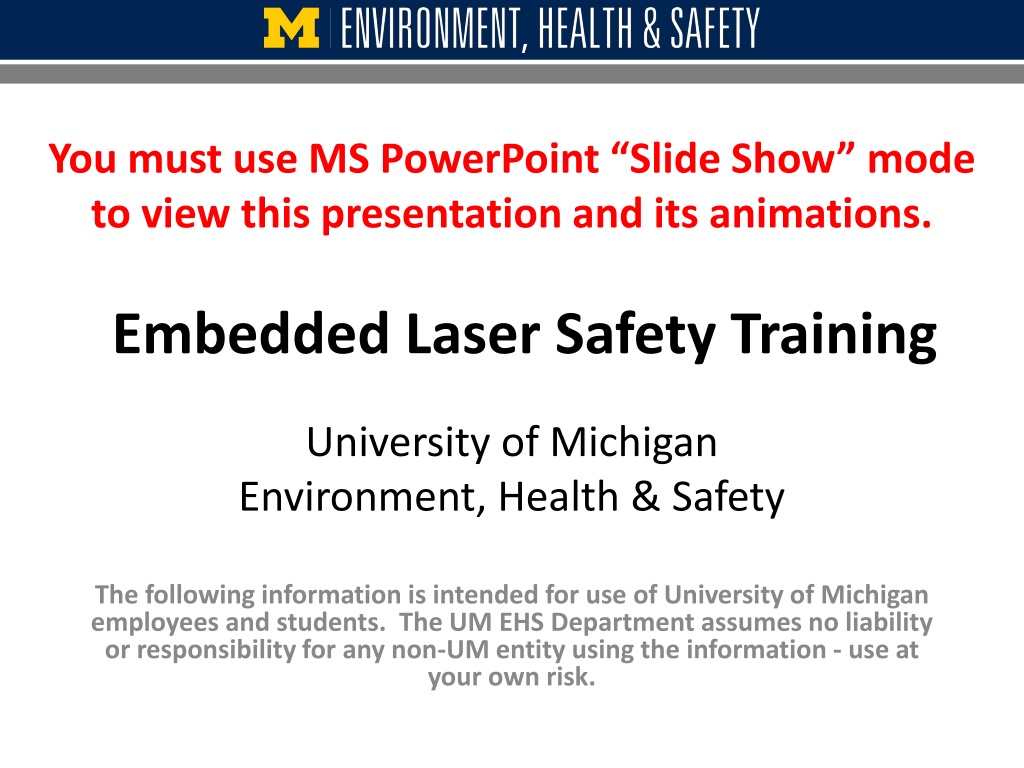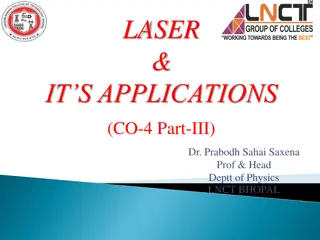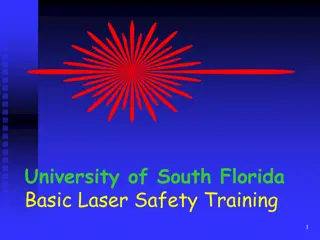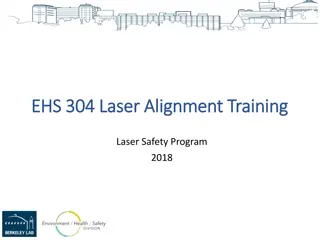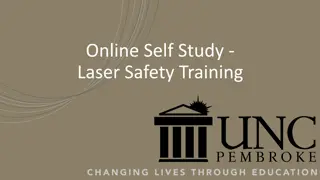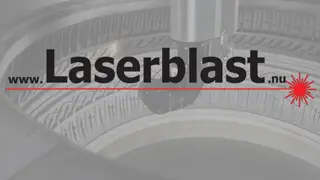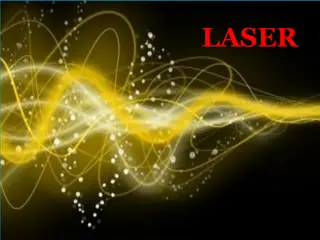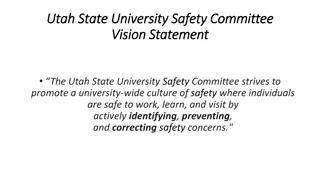Embedded Laser Safety Training at University of Michigan
This presentation focuses on embedded laser safety training at the University of Michigan, covering topics such as laser hazards, responsibilities of lab directors, safe usage of equipment containing lasers, and what to do in case of injuries. It emphasizes the importance of identifying risks, avoiding potential dangers, and taking appropriate action when using embedded lasers. The content provides valuable insights for employees and students to ensure a safe working environment.
Download Presentation

Please find below an Image/Link to download the presentation.
The content on the website is provided AS IS for your information and personal use only. It may not be sold, licensed, or shared on other websites without obtaining consent from the author. Download presentation by click this link. If you encounter any issues during the download, it is possible that the publisher has removed the file from their server.
E N D
Presentation Transcript
You must use MS PowerPoint Slide Show mode to view this presentation and its animations. Embedded Laser Safety Training University of Michigan Environment, Health & Safety The following information is intended for use of University of Michigan employees and students. The UM EHS Department assumes no liability or responsibility for any non-UM entity using the information - use at your own risk.
Embedded Laser Safety Basic Training Self-Study Module This online embedded laser safety training is only a part of the training requirements. Lab Director (LD) must also deliver lab/device -specific instruction to each user. Records of that instruction must be kept by the LD and made available upon request.
Responsibilities of Lab Directors Evaluate laser hazards & institute appropriate controls (with EHS advice as appropriate) Implement safety procedures: Develop written Standard Operating Procedures (SOP) Provide personal protective equipment, if necessary Conduct and document specific training for all users
In this training What is a laser and what is dangerous about it? What is an embedded laser and what are its advantages? How to remain as safe as possible when using equipment containing an embedded laser What to do if someone is injured
Embedded Laser Safety Basic Training After completing this training, you should be able to: Identify the risks of using equipment containing lasers Know how to avoid increasing the risks Recognize and take action if something bad happens when using embedded lasers.
What is a LASER? Why is it hazardous? A laser is a device that makes very powerful electromagnetic waves (including visible ones) : LASER stands for: Light Amplification by Stimulated Emission of Radiation. The energy in this non-ionizing electromagnetic radiation is very useful for many applications but more energy also makes it more dangerous.
Compare the following types of light Regular light sources emit light that has: Multiple wavelengths (polychromatic) Waves out of phase Multi-directional Intensity decreases rapidly Laser light: 1 wavelength (monochromatic) Waves in phase (coherent) Goes in one direction (directional) Intensity can go some distance
Types of injury that enough light energy of differing wave length can cause Wavelength Range Ultraviolet C 200-280 nm Eye Skin Sunburn Skin Cancer Photokeratitis Ultraviolet B 280-315 nm Photokeratitis Accelerated skin aging Increased pigmentation Ultraviolet A 315-400 nm Photochemical cataract Pigment darkening Skin burn Visible Photochemical Thermal retinal injury Pigment darkening Skin burn (400 nm - 700 nm) Near-infrared 700-1400 nm Cataract and retinal burn Corneal burn Skin burn Mid-infrared 1400-3000 nm Corneal burn Aqueous flare, cataract Skin burn Far-infrared 3000-1,000,000 nm Corneal burn Skin burn
Viewing a laser beam directly or when reflected can cause eye damage Likely to cause harm if enough energy Specular Reflection (flat surface) Direct Beam ALSO likely to cause harm: Specular Reflection (curved surface) Viewing the beam from a distance from the side is unlikely to cause harm but there must be no reflections. Diffuse Reflection
To use a laser beam safely, it is important to know: What is the maximum energy/power What is its wavelength (visible, invisible- UV, IR) How well the laser beam is shielded and controlled so that users and non-target materials are protected This information has been combined to classify lasers into seven classes.
The lower the number, the less overall risk, if the equipment is used correctly/maintained properly. Class 1 Considered incapable of producing damaging radiation levels during operation. Common example is an embedded higher class laser. The laser beam may be powerful enough to cause serious injury, but physical shielding and control mechanisms mean risk of exposure to users, and anything else except the intended target, is minimized. For this reason, specialized personal protective equipment is not usually required. Check with your Lab Director to be sure.
Class 1M A Class 1 system with magnifying optics. Example is a communication fiber optics system. Class 2 Eyes are protected because of the natural blinking response. Example is a supermarket bar scanner. Class 2M - A Class 2 laser with optical aid. Example is a construction industry laser Class 3R Most laser pointers. Typically the red dot used in a laser cutter to line up material. Eye may be protected using natural blinking response. Class 3B - These can be hazardous under direct and specular reflection viewing. Diffusive reflection and fire are not normally a hazard with Class 3B. Many embedded systems contain Class 3B lasers, but these systems have shielding and interlocks to prevent direct viewing of the beam. Class 4 Laser inside a laser cutter is a high powered laser. Both direct and scattered (diffuse) beams can cause eye and skin damage. Do not override interlock.
All these pieces of equipment may contain embedded lasers: Confocals TIRF microscopes Two-photon microscopes Cytometers Mass Spectrometers Laser Cutters
Embedded lasers are completely enclosed in a solid casing. In confocals and other microscopes containing lasers, their beams travel along optical cables to site of use. These systems also have interlocks to prevent accidental exposure to a beam. If interlocks are bypassed, injury or exposure may occur. There is still risk of exposure and injury if the casing/cables are damaged or removed.
Engineering Control Measures Protective Housings Confocal with laser and fiber optic cables. Head pivots back and interlock prevents direct viewing of laser beam if instrument is on.
EngineeringControl- Interlocks Laser cutter with high power laser. Laser beam that cuts is invisible. Red dot is Class 3R like a laser pointer. If panel on top or in front is opened during operation, interlocks should shut the device down.
Therefore to minimize risk of injury Nevertry to see inside, break or remove any casing, or expose the lasers or laser beams Never try to override an interlock mechanism Never let untrained people use the equipment If you think there is something wrong with a laser or interlock: report it to your Lab Director Only specialized laser personnel from laser manufacturer may repair, or service embedded laser equipment.
Stay healthy to stay safe! Electrical Hazard More than a dozen fatal electrocutions in laser- related accidents have been reported in America. The principal factors influencing the accidents in order of their frequencies are user-related: Fatigue Hunger Medication Alcohol Drug These are your responsibility! Do not continue to use equipment if you have problems with these!
How to work safely with lasers 1. Understand how to use specific equipment that includes lasers 2. Have training to understand what you must do and what you must not do to stay safe Read the Laser Safe operating procedure for your lab! Make sure your work place is properly labelled 3. Know how to get help if the equipment isn t working properly (in any way) if there might be a problem with laser, interlock, or protective cover if there is an injury or potential injury situation
Standard Operating Procedure (SOP) A concise document that gives safety instructions specific to the laser and associated equipment. It should include: a System Description Eye, Skin and Non-beam Hazards Control Measures and Emergency Procedures Training Requirements List of Approved Personnel Let your Lab Director know if you think any information is missing or needs updating
Important ways to ensure everyone is protected from laser-related injuries Prominent door signs Check with your Lab Director/EHS Laser Safety Officer that your workplace has the correct signage Make sure these details are filled in, you may need to use them
If the laser beam may be exposed, everyone must be warned not to enter the room! e.g. when an embedded laser is being aligned, repaired or serviced by qualified experts
Embedded laser equipment has been designed to reduce the risk of direct laser beam-related injury to an minimum. However, if you think you have been exposed to the laser beam/are injured: Evacuate the room and shut the door, Tell others not to enter and why so that the room can be labelled as potentially dangerous. Inform EHS. Get help with going to the emergency room/occupational health if required Fill out an accident report or help lab manager or lab director to do so.
What Do I Do in an Emergency? If it is an emergency, go to the U-M Hospital System Emergency Room (UMHS - ER). For non-emergency treatment: Employees of U-M should go to Occupational Health Services, Monday Friday from 7:00 am 4:30 pm; after hours or on weekends go to the UMHS ER. Students of U-M should go to University Health Services. If injured, notify your advisor and you must complete the Work Connections Illness/Injury Report Form http://www.workconnections.umich.edu/employees/work- related-illness-injury/step-one/ If you do not fill out this form, you will be billed directly.
U-M Occupational Health Services 7:00 am 4:30 pm Monday - Friday C380 Med Inn Building University of Michigan Hospitals 1500 E. Medical Center Drive Ann Arbor, MI 48109-5838 Phone: (734) 764-8021 Fax: (734) 763-7405 For evenings/weekends/holidays, please use the UMHS Emergency room.
Applicable Standards, Regulations, and Guidelines American National Standard for Safe Use of Lasers (ANSI Z136.1-2014) American National Standard for Safe Use of Lasers in research, development, or testing (ANSI 2136.8-2012) General Duty Clause [29 CFR 1910.5(a)(1)] Each employer shall furnish a place of employment which is free from recognized hazards that are likely to cause death or physical harm to employees Laser Product Performance Standard (21 CFR 1040.10 and 1040.11) EHS Laser Safety Guideline: http://ehs.umich.edu/wp-content/uploads/2016/02/LaserSafety.pdf
Thank you for your time in completing this presentation. We hope you have found its content both useful and informative. For further questions and/or inquiries, please contact: Laser Safety Officer at 734-647-5224 or UM Environment, Health and Safety at http://ehs.umich.edu
